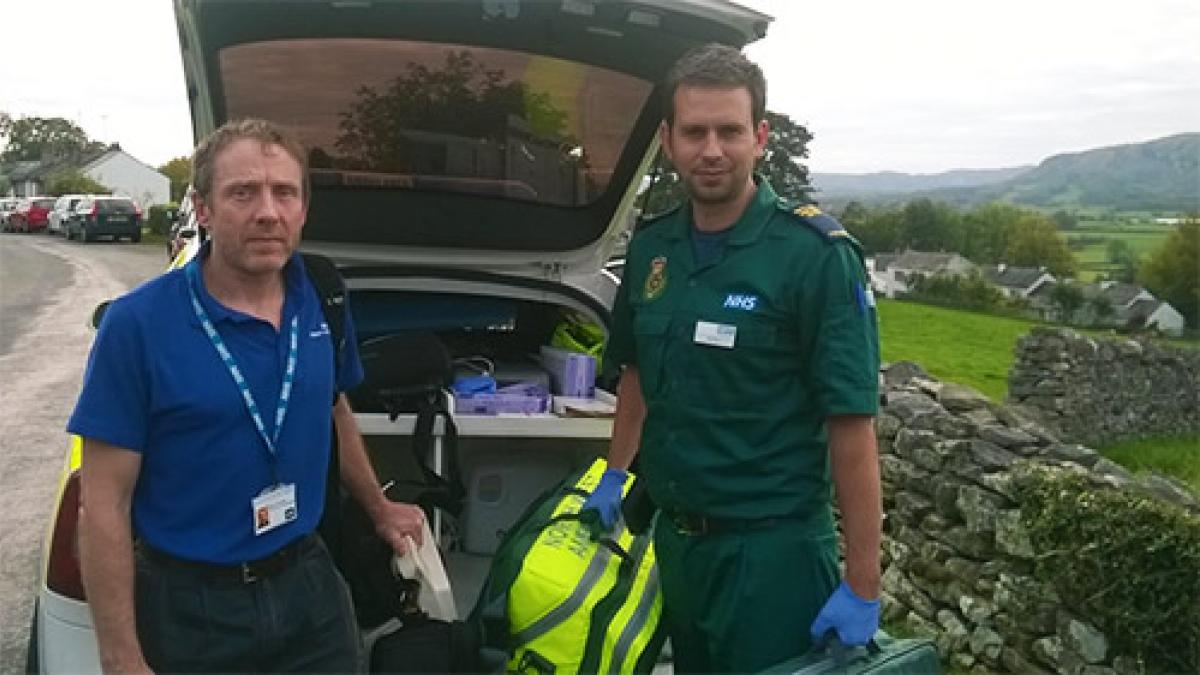A physiotherapist and a paramedic joined forces in a pilot project in which they responded to emergency calls that were not life-threatening.

Pilot partners: senior community physiotherapist Gavin Thomas, left, and urgent care specialist paramedic Steve Burn
Gavin Thomas, a senior community physiotherapist at Cumbria Partnership NHS Trust, teamed up with paramedic Steve Burns during the six-week trial.
Together they provided an urgent rapid response service, which aimed to prevent unnecessary A&E attendances and reduce hospital admissions.
Mr Thomas travelled in an ambulance car with Mr Burn, and provided expert physiotherapy input to people in the Furness and South Lakes areas of Cumbria.
He told Frontline: ‘Working with Steve was brilliant. His critical care skills meant that it was always really safe walking into anything. Our two skill sets complemented each other very effectively and we quickly morphed into a very efficient team, with each knowing what the other needed to do as scenarios unfolded.
‘Many of the patients had phoned 999 –not because they wanted to go to hospital, they had just run out of options and panicked or felt frightened.
‘So the two questions I asked myself with every patient were "What does going to A&E offer this patient today?" and "What do we have to do now to keep this patient at home safely?"’
Cost saving
The project focused on people who had been injured in falls, but the team also attended calls about other non-life-threatening conditions. These included people experiencing loss of mobility, frailty, chronic pain, urinary and chest infections and exacerbations of long-term conditions such as chronic obstructive pulmonary disease.
‘A lot of these patients do not need to be taken to A&E and we have shown that the skill mix of a paramedic and a specialist community physiotherapist can keep them at home,’ said Mr Thomas.
The pair responded to 61 incidents in the trial earlier this year. Of these 49 were due to falls in the patient’s own home, 10 were non-fall-related ‘green’ calls (non-life-threatening) and two were non-fall-related ‘red’ calls (life-threatening).
Data from the trial show that
- 35 patients (57 per cent) remained at home
- 15 (25 per cent) were transferred to A&E
- 11 (18 per cent) were transferred to a local primary care assessment centre
By helping many patients to stay at home or receive care in the community the trust estimates the pilot saved £2,850 every time a person was not transferred to hospital.
Community options
Mr Burn told Frontline: ‘Joint working with a physiotherapist enabled other community-based options to be explored and implemented rather than conveying patients to acute settings.
‘We learned from each other and developed a greater understanding of how our different services work and identified ways of us working together more closely in the future.’
Sue Clarke, team lead for community physiotherapy, said: ‘The whole team were involved as we had to allocate work differently in order to release Gavin from his “day job”, so he could concentrate on the pilot.
‘A business case for the service is being compiled and will be submitted to the commissioning team. But if anyone else around the country is involved in similar projects we would love to hear from them so we can share ideas.’
Email Sue.Clarke@cumbria.nhs.uk
Number of subscribers: 0